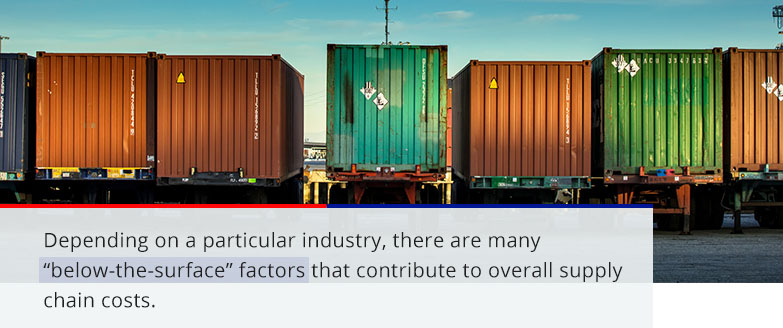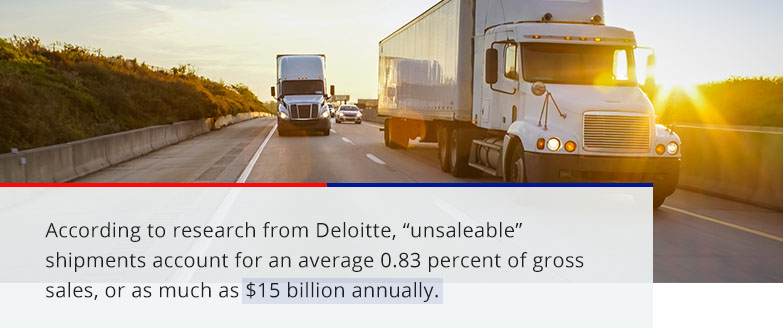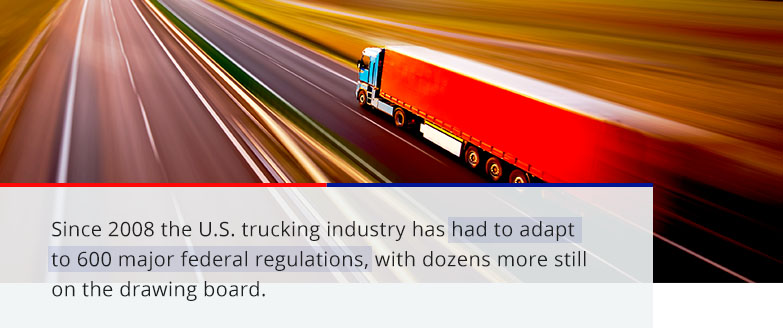Blog
Understanding Hidden Costs in Your Supply Chain

When the Council of Supply Chain Management Professionals (CSCMP) released results from its annual “State of Logistics” survey in June 2016, it cited strong growth in the $82.2 billion parcel and express sector, which had been fueled by double-digit growth in eCommerce. While hardly a surprise, the strong pace of growth in eCommerce would seem to be a boon for online retailers.
But maybe not as much you might expect. Consider a separate survey, the “Walker Sands Future of Retail 2016” study, which was reported on by Marketing Land and found nine out of 10 survey participants expected free shipping on their eCommerce orders, while 68 percent said they expect free returns and exchanges.
In fact, free shipping and product returns are among the many factors that often go unreported when considering overall transportation spend or logistics costs. Such “hidden costs” can result in a business losing track of the actual costs of transporting goods or, worse, being unaware of the additive impact of these costs on the bottom line.
For example, research by McKinsey & Company found pharmaceutical manufacturers spend roughly 2 percent of total sales on logistics costs, with transportation accounting for 1.5 percent, warehousing costing 0.3 percent, and the remainder accounted for by incidentals including administrative costs.
A closer look though reveals that within the transportation category, three factors had a disproportionate effect on overall costs:
- Temperature-controlled distribution. The McKinsey analysis notes that while 98 percent of product is serviced via an ambient distribution chain, the 2 percent that had to be shipped in refrigerated vehicles accounted for nearly half of total transportation costs.
- Special delivery services. Shipments sent via “express delivery guaranteed by 10am next day” cost two to five times more than regular 24-hour delivery.
- Shipment size. Most shipments tend to weigh less than five kilograms, but these small shipments cost roughly six times more per kilogram than larger shipments. And even when companies manage to consolidate deliveries into larger shipments, many potential cost savings opportunities are not implemented.
Attention to these categories, including a few relatively simple adjustments, could result in savings of 20 to 30 percent of total transportation costs.
Depending on a particular industry, there are many “below-the-surface” factors that contribute to overall supply chain costs. Product returns are a good example. How a retailer chooses to handle the roughly 9 percent of sales that are returned can have a significant impact on its bottom line – as can the number of shipments that arrive damaged or the growing costs of complying with state, federal, and international regulations.
Many logistics managers fail to delve into the underlying factors driving their warehouse, transportation, and logistics costs. The following discussion will shed light on some of these issues and offer guidance for minimizing, possibly even eliminating, their outsized impact on supply chain costs.
McKinsey & Company’s intense review of “typical” pharma supply chains concluded: “Up to half the cost of many supply chains lurks ignored and unmanaged in outbound logistics and behind the closed doors of distribution centers.” And in a subsequent McKinsey report, researchers concluded that overall, costs could fall by $130 billion if the industry “adopted straightforward advances well established in other industries.”
Some of those “straightforward advances” involve strategic overhauls in supply chain operations – process improvements, greater reliance on data, and better collaboration – which require fundamental shifts in management. But short-term cost reductions can be found by recognizing some opportunities to address issues that are “hiding in plain sight.”
Following is an overview of key factors that drive up logistics costs, often with significant impact on overall expenditures.
Factors that Increase Shipping Logistics Costs
Free Shipping
Just as it’s widely known that “there’s no such thing as a free lunch,” shippers understand there’s no such thing as free shipping. Someone ultimately has to pay, and how a business absorbs the costs associated with offering free shipping can have a significant impact on the bottom line.
Amazon transformed the concept of “free shipping” with its “Amazon Prime” service, which offers “free” two-day shipping for an annual fee of $99. According to The Wall Street Journal, Amazon spent $11.54 billion globally on shipping costs during 2015 and shipped more than a billion North American packages – nearly seven times as many as its closest rival Wal-Mart.
Mega-retailers like Amazon and Wal-Mart are able to offer free shipping largely because they enjoy significant volume shipping discounts – discounts not available to smaller retailers. As The Wall Street Journal reported, “Barclays analysts estimate Amazon spends $4 to $5 on average per package, compared with $7 to $8 for ground delivery paid by an average business.”
As a result, smaller businesses must find a way to meet customer expectations for free shipping, despite the enormous cost. In most instances, costs are passed along to consumers, either through increased prices or by minimum purchase requirements. But for some businesses, raising prices is not an option since price-conscious consumers will simply switch to a lower-cost competitor.
Such is the plight of one Newark, New Jersey-based home and garden products company that was forced to address the need for free shipping when Amazon entered its genre. The company’s president told The Wall Street Journal that his company spends $15 to $20 per shipment, which accounts for roughly 12 percent of revenue. “We are absorbing more and more of it because we can’t pass along the costs to consumers, because of Amazon,” the president told the paper.
This business is certainly not alone. According to retail management consultant Kurt Salmon, during the 2015 peak holiday shipping season, only 10 percent of online retailers charged a shipping fee. In addition, many retailers were forced to fulfill single orders with multiple shipments, since inventory was generally spread across multiple distribution points. “The bottom line,” the consultant wrote in his annual omni-channel fulfillment study, “is that retailers are now beginning to confront one of eCommerce retailing’s basic issues: It’s less profitable than brick-and-mortar.” Further, the report suggests, as eCommerce continues to grow in popularity, and consumer expectations for free shipping become the norm, retailers will have to confront the cost issue.
Damaged Shipments
According to research from Deloitte, “unsaleable” shipments account for an average 0.83 percent of gross sales, or as much as $15 billion annually. The term unsaleable covers a broad range of reasons a shipment never makes it to a store shelf – including damage, discontinuation, and product expiration. Damaged shipments account for roughly half of all unsaleable goods. As Deloitte’s analysis notes, the impact can be significant to a business’s bottom line:
- Coca Cola reported $230 million in damaged shipments out of $46 billion in sales.
- Pepsi reported $325 million in damages out of $65 billion in sales.
- Proctor & Gamble reported $420 million in damages out of $84 billion in sales.
- Nestle reported $415 million in damages out of $83 billion in sales.
The research noted broad disagreement between retailers and manufacturers with regard to underlying causes of product damage.
“Manufacturers contend that damages are caused while en route from retailer warehouse to store shelf,” the report stated. “Retailers feel that while damages may happen when sorting and moving product, the root cause is package design. Retailers report that certain packaging designs simply cannot withstand the stress of the supply chain, resulting in increased damage rates.”
Other obvious causes of damages include improperly loaded pallets, poorly applied shrink-wrap, faulty packaging, and any number of additional in-transit factors.
Regardless of the cause of damage, a business must contend with the fallout created by a damaged shipment. First, a claim must be filed with the carrier, a process that can take several hours of paperwork and documentation gathering. The claims process will be followed by multiple conversations with representatives from the freight company, and its insurer, to determine liability. The shipper must also use valuable warehouse space to store the damaged goods until a decision is made about their salvageability. According to A&A Customs Broker, the costs associated with a freight claim can often exceed the reimbursement amount.
These costs are in addition to the potential damage done to a customer relationship, especially if the shipment is meant for a manufacturing assembly line or a similar time-urgent situation.
A shipper must have a plan in place to immediately alert a customer that its shipment has been damaged and to issue a replacement shipment as quickly as possible, often via an expedited transit solution.
Product Returns
The National Retail Federation reports the typical retailer can expect product returns to account for 8 percent of total sales. And of those returns, only about 20 percent will be damaged or defective.
But whereas in the past returns were regarded as an automatic drain on the bottom line, today’s retailers recognize the tremendous impact a consumer-friendly returns policy can have on building relationships with customers, not to mention the opportunity to recapture value for those undamaged returns in an outlet store or other secondary market.
Research by comScore found 81 percent of consumers expect a hassle-free returns process with no charge for shipping, and 63 percent say they review a retailer’s returns policy before making a purchase. Perhaps most telling though is research by ShopRunner/Harris Interactive, which found 81 percent of respondents said they would be less likely to make additional purchases from a retailer that did not offer free returns shipping and a convenient process.
Despite the obvious strong demand for lenient returns policies that feature free shipping, most businesses – over 90 percent according to a SmartHub study – charge for returns shipping. This reluctance to embrace the trend toward omnichannel flexibility and the “customer is king” mentality is largely driven by cost. Free returns shipping comes at a cost.
For many retailers, according to Hofstra University Professor Barry Berman, the tendency is to focus on the short-term implications of returns – shipping costs, repackaging fees, and price reductions associated with merchandise not being resaleable as new. Berman also cites the concern that a lenient returns policy will result in “abuse” of the policy by consumers who purchase a product for a specific purpose only to return it after that initial usage.
Similarly, analysis by CNBC noted many retailers’ concerns for their short-term bottom lines: “Offering free return shipping is an investment. When your focus is on cutting short-term costs and pumping next quarter results, cutting down on shipping costs makes sense.”
Businesses are under increasing pressure to be as flexible and generous as possible with their returns policies. There are opportunities to streamline the returns process, possibly by enlisting a single logistics provider to handle the entire process. An experienced logistics provider could help a retailer develop a returns strategy that is affordable, but also embraces the flexibility and efficiency customers so clearly demand. Another consideration is ensuring a direct route to certain secondary markets. According to Inbound Logistics, secondary market sales are valued at $400 billion annually, with retailers typically recapturing 12 to 25 percent of an item’s original cost.
Regulatory and Compliance Costs
Research by Inbound Logistics found that since 2008 the U.S. trucking industry has had to adapt to 600 major federal regulations, with dozens more still on the drawing board. The regulations affect a broad swath of trucking-related operations, including emissions, reporting of accidents, hours-of-service (HOS), electronic onboard records, and fuel-mileage standards. As with all regulations, there is a cost to compliance, and most of these costs will be passed along to shippers.
This increase in federal regulatory activity is in addition to actions implemented at the state level. Individual states are enacting their own standards and mandates, resulting in a “patchwork” of compliance requirements from state to state. This is also forcing freight companies to pass along costs to shippers, with some LTL carriers instituting a “California surcharge” of 2 percent or more to cover that state’s unique emissions standards, overtime pay, and mandatory break requirements.
America’s neglected infrastructure is another hidden cost passed along to shippers. Forbes Magazine reports that traffic congestion costs the U.S. trucking industry nearly $50 billion annually and resulted in 728 million hours in valuable delivery time spent stuck in traffic jams. According to the American Transportation Research Institute, as reported by Forbes, this amounts to about $26,000 per truck. “At the end of the day,” the article notes, “the consumer is going to pay more because transportation costs are going up.”
These hidden fees are in addition to customs and brokerage fees that are incurred every time a shipment crosses an international border. These costs include duties and tariffs, inspection fees, documentation processing costs, sales taxes, bond costs, and charges assessed by a customs broker.
Inefficiencies
When analysts from McKinsey examined the typical pharma supply chain, they found that although warehouse and transportation functions account for 95 percent of overall logistics costs, most companies have not implemented “lean” techniques that could save 20-50 percent in warehousing costs and up to 40 percent in transportation costs.
The analysts examined supply chains of more than 40 different companies worldwide. Rather than find one or two major “smoking gun” obvious mistakes, the analysts found “the cumulative effect of dozens of slightly suboptimal processes and the lack of a lean mindset” were causing companies to waste money on inefficient processes.
Among areas singled out for improvement:
- Warehouses in need of makeover. Many warehouses were designed years ago for a particular purpose that is no longer relevant. But, in most cases, these warehouses have not been reconfigured to meet the realities of today’s technology-driven world. As a result, order fulfillment tends to take considerably longer than in a modern facility, with far too many touches. One example highlighted a
pharma warehouse in which pickers were required to put labels on all products bound for hospitals. Pickers would retrieve products, put a label on each package, and return it to its original location. “By attaching the label beforehand,” the report noted, “this step could be completely eliminated, saving 50 percent of the pallet picking time.” The report found additional waste in how pallets were received, duplication of processes, and a general failure to develop and implement “best practices.” Together, these inefficiencies were driving up warehousing costs, which were passed along to shippers, often buried deep in a monthly service invoice.
- Higher levels of service than necessary. Supply Chain Quarterly profiled one company that provided next-day delivery to all of its customers – even though not every customer needed or wanted it – a situation referred to as “over servicing” an account. A second example highlighted a distributor that, in an effort to pacify complaining customers, offered free delivery. This attempt to placate customers cost the distributor $500,000 over the course of a year. But, the article notes, “both the distributor and its customers would have been better off if the distributor had eliminated the complaints by ensuring that the underlying problems did not happen again.”
- Excess packaging costs. Especially relevant for eCommerce shipments, many shipments are packaged in outsized containers filled with Styrofoam peanuts or other types of filler that drive up shipping costs. The incidence of small items packed in large boxes stuffed with packing peanuts came to head when, in 2015, many U.S. ground shippers implemented dimensional weight pricing (DIM weight), whereby freight costs are assessed based on package density rather than simply on weight. With DIM pricing in place, improperly packaged shipments can cause freight costs to increase by as much as 30 percent.
- Improper freight classification. Most transportation providers rely on shipment standards established and maintained by the National Motor Freight Traffic Association, Inc. (NMFTA). The standards, known as the National Motor Freight Classification (NMFTA), are a way for shippers and carriers to establish benchmarks for determining shipping rates for different types of commodities. Commodities are grouped into one of 18 classes – from a low of class 50 to a high of class 500 based on four characteristics: density, handling, stowability, and liability. According to NMFTA, a shipment’s NMFC designation will provide “both carriers and shippers with a standard by which to begin negotiations and greatly simplify the comparative evaluation of the many thousands of products moving in today’s competitive marketplace.”
However, mistakes can happen. Since freight classification assignments can be arbitrary, a shipper needs to pay attention. Examine freight bills closely, and raise any suspicious charges with a freight provider. An even better approach would be to negotiate with the carrier prior to service being rendered to ensure that both parties are in agreement with the assigned classification. Many transportation providers have minimized the risk of mistakes by implementing transportation management systems, but all shippers should be aware of the potential for a mistaken classification.
- Unexpected accessorial charges. Liftgate fees, inside delivery charges, and after-hour pickup costs are among the “extra” fees – known as accessorial charges – commonly assessed by transportation and logistics providers. But these charges can be downright infuriating and costly when they come as a surprise and are not included in a carrier’s initial service estimate. And, since accessorial charges are often not part of an agreed-upon service rate, many carriers inflate accessorial charges to recoup revenue after submitting an especially low quote. The quoted rate of service may be low but, after accessorials are added in, overall costs can exceed rates charged by other carriers who were considered too expensive. A shipper can help control accessorial charges in several ways. First, request a list of accessorial fees during the carrier negotiation process, then a shipper can negotiate with a carrier to determine precisely which extra services will be necessary and what the charges will be for those agreed-upon services.
Why A Logistics Provider With Your Bottom Line at Heart is the Solution
An experienced logistics partner will make your goals their own. The right logistics partner will understand your priorities and needs, and they will deliver transparent, dependable customer service to complement innovative shipping solutions.
At Purolator International, we deliver on our promise to always view our work together as a partnership, and we are only satisfied when your customers are satisfied, too. For a logistics partner that you can count on, reach out to us today. We proudly deliver Canada.



